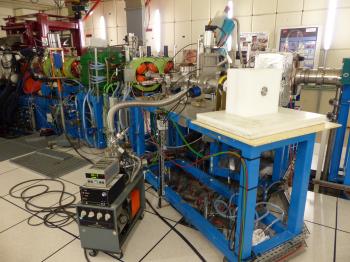Context
The High Intensity Proton Injector (IPHI) is a proton accelerator.
IPHI features a proton beam with the following characteristics: E ≤ 3 MeV, 1 mA ≤ Ipeak ≤ 100 mA, duty cycle from 1 ms / 1 Hz up to continuous mode. In addition, the facility can be used as a neutron source at low flux (109 – 1010 n/s).
The facility can be used to:
- develop and test high intensity beam diagnostics or beam devices,
- perform thermal studies at high power,
- test beam intercepting targets,
- irradiate samples with protons or neutrons,
- optimise neutron moderators or test neutron diagnostics.
IPHI is using a 352 MHz RF platform which also serves two additional vaults to test or condition RF components (RF windows, RF power loops, DTLs, etc.…).
As of March 2017, IPHI has been commissioned up to a beam power of 1.5 kW. The commissioning to the design power (300 kW) is foreseen in 2017.
Technical means
- Accelerator located in a dedicated concrete vault for biological shielding,
- Two beamlines: the high power beamline (up to 300 kW) and a low power beamline (300 W),
- Proton current choice and monitoring from 1 mA up to about 100 mA,
- Tunable pulse lengths from 1 ms to continuous mode,
- Tunable repetition rate,
- Vacuum in the proton beamlines at the level of 10-8 mbar,
- Fast neutron source (mean neutron energy = 600 keV) with a total neutron production of 4 109 n/s over 4π,
- Thermal moderator allowing to produce a thermal neutron flux of about 104 n/cm2/s at 1 m from the target.
Achievements, related projects
- Production and characterization of thermal neutrons,
- Tests of two types of beam diagnostics foreseen in 2017,
- IPHI is part of the ARIES European Project for academic research.
Technical steps, expertise
- Simulation of the activation for beam intercepting devices,
- Mechanical implementation on the beam line, experiment installation,
- Connection of the water cooling system,
- Vacuum leak testing,
- Safe beam operation,
- Control of material for activation before dismounting or before leaving the vault.
Contact:





